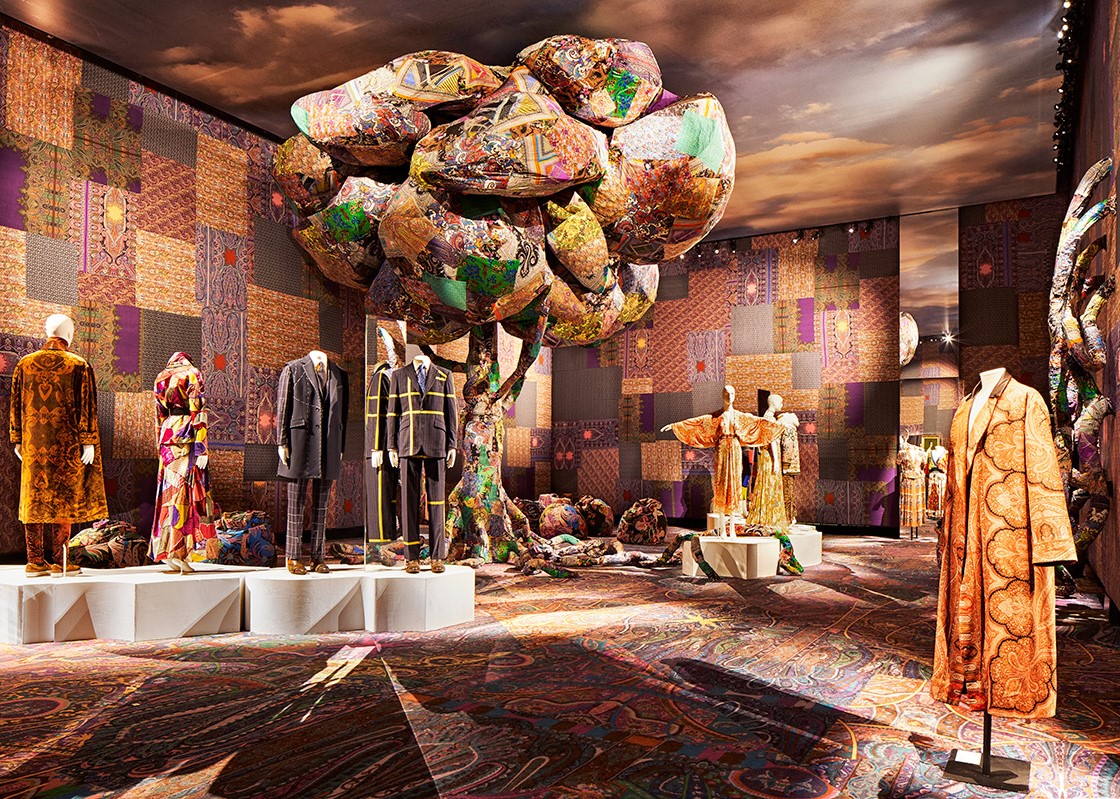
 Patricia Gatto Puglia
Patricia Gatto Puglia
Italian lifestyle and fashion: Thank heaven for Etro’s paisleys
- WTI Magazine #117 Jul 20, 2019
-

 Patricia Gatto Puglia
Patricia Gatto Puglia
I am a lover of paisleys, particularly Etro’s paisleys. The Italian textiles-turned-fashion label has made the teardrop-shaped form with a curvy tail the centerpiece of its brand, creating a sort of paisley heaven for devotees. Every new fashion season brings a refresh of Etro’s paisley patterns -- a new cultural influence, different colors, revamped styles. The endless variations are all still unmistakably Etro.
One of Etro’s strengths is the ability to mix patterns with just the right amount of understatement to make the designs eminently wearable. The paisley motif is often joined with large swaths of colors, sometimes with geometric shapes, or coupled with birds and flowers for a soft, flowy look. Design details like contrasting paisley jacket linings, strategically placed decorations on collars and bodices, elegant tone-on-tone embellishments, and sensuous fabrics all add up to the stylish extravagance and impeccable workmanship of a Made in Italy luxury brand.
Primal paisleys
How did Etro come to adopt the paisley motif, an ancient Mesopotamian pattern based on the seed of the date palm, considered to be a symbol of fertility and long life? The history of Etro provides context.
Gerolamo (Gimmo) Etro founded the Milan-based firm in 1968 to manufacture high-end textiles for the then burgeoning furniture and fashion industries. His fashion clients were the greats of the era – Valentino, Emanuel Ungaro, Oscar de la Renta, and Kenzo among others.
Gimmo’s business was inspired by his passions – travel, art, and distant cultures. He and his wife Roberta, an antiques dealer and the daughter of an Italian textile manufacturer, traveled the world in search of exotic treasures, eventually amassing a collection of early 19th century Kashmir paisley shawls. (The term “paisley” takes its name from the Scottish town of Paisley where woven and printed paisley shawls, the rage in the 19th century, were produced en masse from 1800 through about 1850.) The Etros’ interest in paisleys also took root during the counterculture decades of the ‘60s and ‘70s, when music icons such as the Beatles, Janis Joplin, and Jimi Hendrix brought paisleys back into the limelight. The now 79-year old Gimmo is also said to have been smitten by a brocade paisley nightgown made by his grandmother, which he credits as the source of his love for fabrics.
By 1984, paisley fabrics had become the Etro brand’s signature. Gimmo was producing paisley prints and jacquards using the highest quality silks and cashmere; he was also raising his profile as a purveyor of luxurious bohemian textiles.
Gimmo was an astute businessperson. By 1985, he had already expanded Etro into a “lifestyle” brand, incorporating everything from “quilts to photo frames” (Vogue) in his offerings; Etro was one of the first Italian design houses to diversify. In 1988, the Etro Man and Woman prêt-à-porter lines were being expanded and the Etro flagship store on Milano’s Via Montenapoleone had been launched. International expansion in Europe, the US, and Asia followed along with the introduction of a fragrance collection of heady scents in beautiful bottles etched with paisleys. The textile business continued to flourish, as it does today; Ralph Lauren, Marc Jacobs, Clements Ribeiro and other big-name designers choose Etro’s luxurious prints for their collections.
Reaching the 50-year mark
In September 2018, Etro celebrated its 50th anniversary with an exhibition at Milano’s MUDEC cultural and history museum. The well-researched and -documented exhibit was curated by the Etro family in partnership with the Victoria and Albert Museum in London. Fifty men's and women's designs from the house were shown with the family's personal objects and photos, introducing the audience to the rich and varied world of Etro. The company promoted the exhibit on its website with a video called Wunderkammer, a German term for “Cabinets of Wonder,” which, along with “Wonder Rooms,” were popular in the Victorian era as places where people displayed their prized possessions and curiosities. Etro puts its workspace, including its “curiosities,” on display in the video.
Etro remains a family affair
Today, Etro remains a privately held company that is present in more than 70 countries. The lion’s share of its revenue (nearly €300 million in 2017) is generated by the womenswear collections. Etro currently operates nearly 200 monoband stores worldwide.
Etro is now run by Gimmo and Roberta’s four children. There are three brothers – Jacopo is the eldest, followed by Kean and Ippolito – and sister Veronica, the youngest, all born between 1962 and 1974. They are a tight-knit family – many decisions are said to be taken around the communal lunch table at the company’s offices on Via Spartaco in Milano. Each sibling brings his or her distinct talents to the organization and has roles and responsibilities to match. Outside talent is increasingly part of the management mix.
The connective tissue, in addition to the bloodlines, is a shared “passion for art, history, culture and above all an innate curiosity,” said second-born Kean Etro in an interview with GQ in December 2018. The Etros have had the privilege of being raised surrounded by art, antiques, and knowledge; that exposure has certainly honed their creative and social sensibilities.
Jacopo, the eldest, joined Etro at 20. He is responsible for accessories, leather, textiles home furnishings, and the newly established furniture division.
Kean is the creative force behind the menswear collection. His passions are folklore, anthropology and ethnology. He designed Etro’s first womenswear line in 1990 and first menswear collection in 1997. When his sister came onboard in 1998, they shared the responsibility for the women’s line for a time before Veronica took it over in 2000.
Ippolito, third born, keeps a low public profile. Educated at the University College London (degrees in biology/business and economics) he worked in financial services in the US after college, then managed Etro’s new office in New York City, and subsequently became General Director of Etro in Italy until 2014. He now plays a role in defining Etro’s commercial expansion.
Veronica is the creative force and shining light behind womenswear and the frequent public face of Etro. She graduated from the Deutsche Schule in Milan (she is completely fluent in German) before studying at the prestigious Central Saint Martin, a college of the University of the Arts in London. Her collections have met with excellent critical acclaim.
Paisleys made in Puglia
Globetrotters by rearing and temperament, the Etro family members are also strongly committed to their Italian roots and core identity – their appreciation for Italian culture expressed in local crafts and craftsmanship runs deep. Kean appears to be the architect of the Etro strategy to produce a part of their fashion wares in the family factory in the region of Puglia. In GQ, Kean recently called the Etro operation in the Itria Valley in Puglia “a highly prolific hotbed of factories making jackets, shirts, suits, trousers and even jumpers.” He expressed being “deeply involved this concept of producing everything locally, up and down the Italian peninsula.”
Bravo Kean. Bravo Etro. My somewhat selfish hope is that Etro remains true to its distinctive paisley heritage, a little piece of heaven when it comes to luxury, color, form, and sheer creativity.